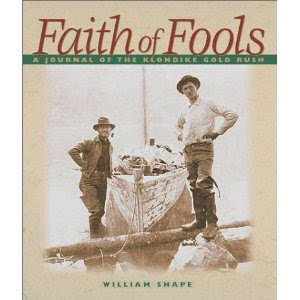William Herrmann Shape

William Shape was born on this day, March 1, 1867 in Milwaukee to a hard working Wisconsin family. His mother and father were from Germany and his father ran a beer bottling plant. The middle child of a brood of 8, he was well schooled and had traveled widely in Europe before he left his wife and two children to seek even greater wealth in the Klondike.
111 years old today!
Happy Birthday to White Pass! The 110-mile White Pass and Yukon Route railroad (WP&YR) was completed with the driving of the golden spike on July 29, 1900, in Carcross, Yukon Territory. The railroad connected the deep water port of Skagway, Alaska, to Whitehorse, Yukon Territory, and beyond to northwest Canada and interior Alaska. Built in 1898 during the Klondike gold rush, construction of the WP&YR was considered an impossible task, but it was literally blasted through coastal mountains in only 26 months, from May 28, 1989, to July 29, 1900.
The railroad was built to replace narrow, dangerous White Pass Trail, also known as Dead Horse Trail, which was taken by prospectors heading from Skagway to the Yukon and Atlin goldfields. Each prospector was required to carry one year’s provisions, or about 2,000 pounds of food and supplies, on the trek north. Because a prospector usually could not carry more than 80 pounds at up the trail at one time, each individual had to climb the mountain 25 or more times. To ease the load, nearly 4,000 horses were brought in. The prospectors worked or starved all but a few horses to death, giving the route the nickname “Dead Horse Trail.” The completion of the White Pass & Yukon Railroad provided an easier route for crossing the mountains, and prospectors and others thereby escaped the backbreaking work of transporting required supplies to the goldfields.
The $10 million project was the product of British financing, American engineering, and Canadian contracting. Tens of thousands of men and some 450 tons of explosives overcame harsh and challenging climate and geography to create “the railway built of gold.” The railroad climbed almost 3,000 feet in just 20 miles and featured steep grades of up to 3.9%, cliff-hanging turns of 16 degrees, two tunnels, and numerous bridges and trestles. The steel cantilever bridge was the tallest of its kind in the world when it was constructed in 1901. To keep British backers of the project appraised of the railroad’s progress, both during and after construction, Barley was hired as a full-time photographer.
In the early 1900s, the WP&YR held a near monopoly on traffic to the goldfields, slowing much of the travel on alternate routes into the Yukon. One such route was the 300-mile Dalton Trail, which connected Pyramid Harbor near Haines on the Pacific Coast, to Fort Selkirk on the Yukon River. The WP&YR route began in Skagway, with stops along the route at what were originally major construction camps, including Log Cabin, Bennett, Carcross, and Robinson, before ending at Whitehorse. Today the WP&YR is Alaska’s most popular shore excursion, operating on the first 66 miles of the original 110-mile line (Skagway, Alaska, to Carcross Y.T.) and carrying over 300,000 passengers during the May to September tourism season. The narrow gauge White Pass & Yukon Route Railroad is an International Historic Civil Engineering Landmark, a designation shared with the Panama Canal, the Eiffel Tower, and the Statue of Liberty.
Seen above is the bridge over the Nares River from Lake Bennett to Lake Nares at Carcross. The spike ceremony happened just in front of this bridge, where the photographer is standing.


